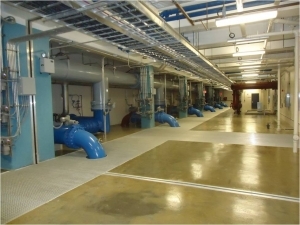Dehumidification plays a key role in the housekeeping maintenance of waste and fresh water treatment facilities. Metal surfaces such as holding, treatment and filtration tanks, pipes and pump room equipment are exposed to cold water that often brings their surface temperature below the room’s dew point temperature. When this happens, moisture forms on these surfaces causing rusting and corrosion.
 In fresh water treatment plants located above ground, water sourced from the ground may be as cool as 50 degrees Fahrenheit. Water taken from lakes or rivers can fall as low as 33 degrees F during colder months. Below-ground fresh water treatment facilities can face even greater moisture control challenges than above-ground installations.
In fresh water treatment plants located above ground, water sourced from the ground may be as cool as 50 degrees Fahrenheit. Water taken from lakes or rivers can fall as low as 33 degrees F during colder months. Below-ground fresh water treatment facilities can face even greater moisture control challenges than above-ground installations.
However, proper application of an industrial dehumidification system can maintain the room dew point temperature three to five degrees below that of the coldest surface temperature. This helps control moisture formation on metal surfaces and prevent premature corrosion of equipment.
Waste water treatment facilities experience similar challenges as fresh water plants, but have the added consideration of air combustibility within the treatment environment. So, in certain waste water plant applications, industrial dehumidifiers must be designed and built to Class 1, Division 2 standards of the National Electrical Code (NEC) for “explosion proof” equipment enclosures.
Each fresh and waste water treatment plant is unique and may require a custom solution. Learn how DCA helped a fresh water treatment facility address its moisture control issues in this case study. We can also help you identify moisture problems in your fresh or waste water plant, and suggest a dehumidification solution. Contact DCA for more information.





